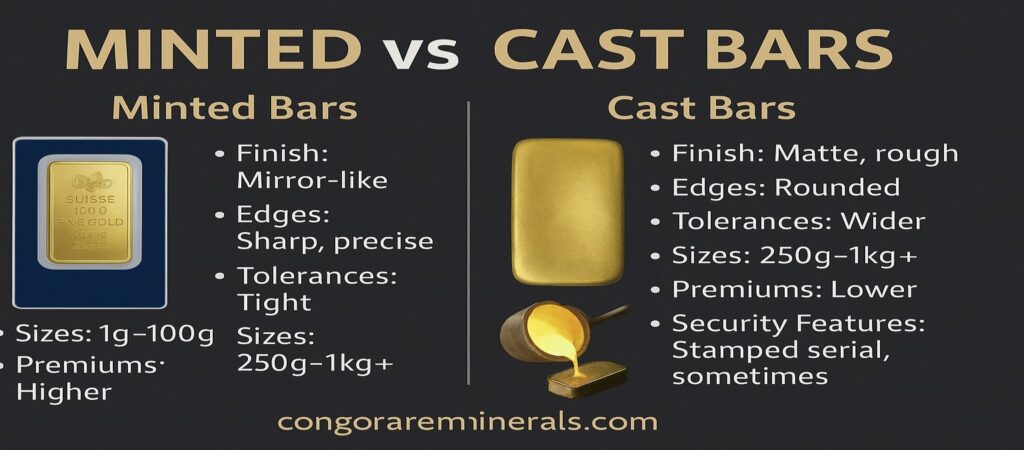Coins get all the attention, but bars are where serious savings show up. If you’re buying physical gold to hold and eventually resell, you’ll run into two main types: minted bars and cast bars. They are both pure gold. They are not the same product once you look at how they’re made, how they’re priced, and how they’re verified.
The short version
- Want the clean look and easy retail resale: choose minted bars (often in tamper-evident cards) up to 100 g or 250 g.
- Want the most metal for your money: choose cast bars (250 g, 500 g, 1 kg) with lower premiums per gram.
- Big orders: mix both. Keep some minted bars for flexibility and a core of cast 1 kg bars for efficiency.
Minted vs cast at a glance
| Factor | Minted Bars | Cast Bars |
|---|---|---|
| How they’re made | Rolled sheet is punched, then precision cut and struck | Molten gold poured into a mold and allowed to cool |
| Look | Sharp edges, uniform finish, often mirror-like | Softer edges, matte or grainy surface, natural pour lines |
| Typical sizes | 1 g to 100 g (sometimes 250 g) | 250 g, 500 g, 1 kg (also larger institutional) |
| Packaging | Commonly sealed in assay card with serial | Usually shrink wrap or simple wrap, separate certificate or stamped serial |
| Premium over spot | Higher (brand, finishing and packaging) | Lower and drops as size increases |
| Liquidity (retail) | Excellent for smaller units | High in standard sizes; large bars may need independent verification |
| Durability | Packaging can scuff or crack; bar is pristine inside | Very robust, surface marks normal from pouring |
| Best use case | Gifts, small monthly stacking, quick retail resale | Larger allocations, vault storage, wholesale transfers |
How each is manufactured
Minted bars
- Pure gold is cast into a slab, then rolled into a thin sheet.
- Blanks are punched or laser-cut to exact dimensions and weight.
- Each blank is struck or pressed to add the mint’s design and hallmark.
- Bars are polished and sealed, often inside a tamper-evident assay card with a printed serial and purity.
Why it matters: tight tolerances and branded packaging make pricing and retail resale straightforward, especially for 1 g to 100 g.
Cast bars
- Gold is melted and poured into a calibrated mold.
- The bar cools, then is weighed, stamped with purity, weight and refiner mark, sometimes a serial.
- Surface can show swirl patterns, bubbles or pour lines. That’s normal.
Why it matters: lower processing and finishing costs mean lower premiums. Cast bars are the standard for 250 g to 1 kg and institutional trades.
What buyers usually care about
1) Premiums and total cost
- Minted: you pay for precision finishing and packaging, so the premium is higher.
- Cast: minimal finishing lowers the premium. The jump from 100 g to 1 kg can save meaningful money per gram.
2) Liquidity and exit plan
- Minted: very easy to quote in the retail channel. Clean packaging helps.
- Cast: still liquid, but large bars (1 kg) sometimes require assay verification to achieve the best bid. Plan for that step.
3) Storage and handling
- Minted: carded bars stack well, but the plastic can scratch.
- Cast: tough and compact. Great for vaults and long holds.
How to verify authenticity
Use multiple checks. That is what professionals do.
Documents and provenance
- Pro forma invoice and final invoice
- Assay report or card
- Certificate of origin (where applicable)
- Serial-numbered bar list for larger bars
- Shipping and insurance papers
Physical checks
- Weight and dimensions: within the refiner’s tolerances.
- Visuals: hallmark, purity stamp, serial number font and alignment.
- Magnetism: gold is non-magnetic.
- Density: water displacement test can catch obvious fakes in small bars.
Instrument tests
- XRF (X-ray fluorescence) for surface composition.
- Eddy-current/sigma devices for through-bar conductivity.
- Ultrasound for internal voids or inserts.
- Fire assay is definitive but destructive and typically reserved for disputes or refining.
If you ever need third-party verification, we can coordinate testing through our Lab Testing and Refining partners, or arrange verification at your nominated facility.
Which should you buy?
Under ~10,000 USD
- Minted 1 oz or 100 g bars. Easy to trade and gift.
- If you stack monthly, minted bars keep units consistent.
~25,000 to 75,000 USD
- Core in 250 g cast for efficiency.
- Add a few minted 1 oz or 100 g for flexible resale.
75,000 USD and up
- 1 kg cast bars for lowest premium per gram.
- Keep a small set of minted bars for partial sales.
Tip: stick to standard sizes and recognized refiners. That keeps quotes tight and resale simple.
Care and storage
- Store in a bank box or professional depository for larger amounts.
- Keep all paperwork together. Serial lists and assay records support better pricing.
- For home storage of small bars, use a burglary-rated safe that is properly anchored, plus an insurance rider if available.
How Congo Rare Minerals makes this easy
- 22K and 24K options with a 100 g minimum.
- Clear documentation for each shipment: invoice, assay, certificate of origin where applicable, insurance and transport papers.
- Insured export to approved destinations and help with verification at your nominated refinery when required.
- Advice on unit mix so you get both low premiums and smooth resale.
Ready to compare live options
- Shop bars: /shop/
- Arrange testing: /lab-testing/
- Discuss refining and paperwork: /service/refining/
- Talk to sales: /contact-us/

